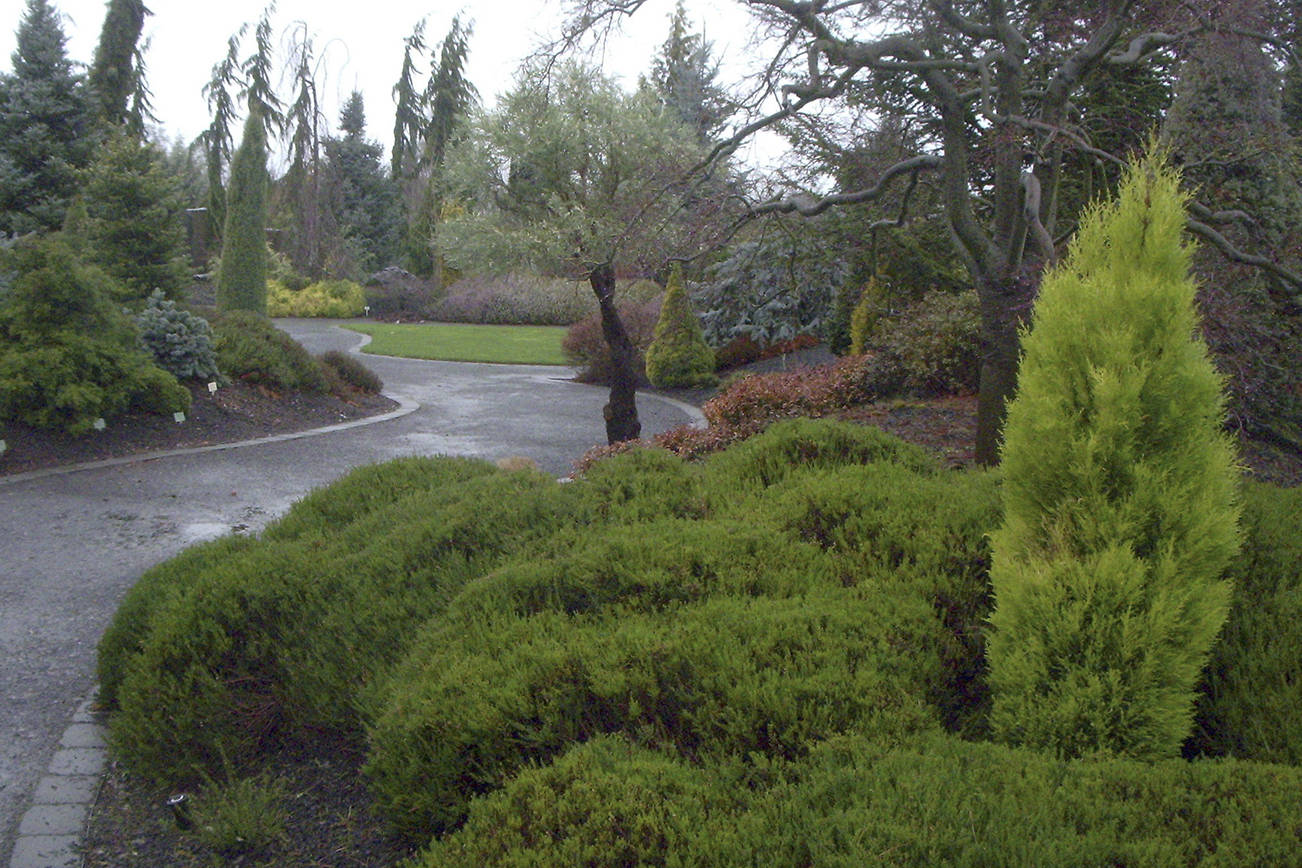By Beth Day Waters
WSU Master Gardener
Like flowers? A lot? Most of us do, as they make for delectable eye candy in our summer gardens.
How about brown sticks and mud? Not so much? That’s what we’re often left with after the riot of summer color fades and our Maritime Northwest winter ensues.
What’s wrong with this picture? Can we have our candy and eat it too? Let’s widen our lens and step inside the garden.
As a new Pacific Northwest transplant, I was amazed by the variety of plants that grow in this climate. When (just shy of) the sky is the limit, where would I begin?
I elected to take a college course with renowned plantsman Dan Hinkley, and to immerse myself in plant ID during the spring of 1995. Later that summer my husband, Steve, and I bought a piece of land and replaced brambles with native conifer seedlings (firs, cedars, spruces, hemlocks) as a living fence.
After that came plantings with colorful, exfoliating bark (Stewartia, paperbark and striped-bark maples, oakleaf hydrangea); winter flowering, olfactory delights (witch hazels, grape hollies, daphnes, sweetbox, jasmine); bright berries (hollies, wintergreen, viburnum); and ornamental grasses (little bluestem, sedges, sweet flag, mondo grass).
I discovered along the way that the science of plant life works hand-in-hand with the art of landscape design to create an artistically beautiful and functionally sustainable garden — true aesthetics.
As a recently retired art teacher, I continue to think about shaping space with design elements and principles in mind. Here’s the gardening baker’s dozen:
1. When you see a plant you like, buy or propagate multiples. This repetition creates continuity and rhythm — a visual echo — throughout the garden.
2. The proportion of one larger plant to every or so smaller ones creates balance.
3. Select a variety of fine, coarse, puckered, fuzzy and spiny leaves and needles, creating textural interest.
4. Explore the spectrum of evergreen hues — clear yellows, amber-golds, steely blues and rich, vibrant greens. Cross over to the opposite side of the color wheel for eye-catching emphasis with winter wonders like winterberry hollies, Midwinter Fire dogwood, Diane witch hazel, and Sango Kaku, Winter Flame and Red Wood Japanese maples.
5. Create a variety of shapes from tall, skinny punctuation marks to mounds, spreaders, vase-shaped, triangular, upright and weeping forms.
6. Consider a balance of straight and curved lines, and a balanced juxtaposition of hardscaping with plantings.
7. Give plants room to grow to their eventual sizes, allowing each to strut its stuff unimpeded.
8. Create small vignettes that blend into the larger landscape, each with a plant that serves as a focal point, with a supporting cast of complementary characters.
9. Choose plants in proportion to the surrounding landscape: Big Sky translates to a few upper-story trees. A stunning view or a small yard suggest smaller plantings that respect the view and are in proportion to the available space, rather than cover or overwhelm it. Small yard and unattractive view? Consider tall conifers with a narrow footprint.
10. If upper-story plantings relate to the sky, midstory plants speak to the human scale: you and me. Understory plants of various shapes and sizes, along with ground covers, fill in beautifully around larger ones, and help the gardener avoid (some of) the weeds and ubiquitous mulch mountains.
11. The sight and sound of movement — with water and a solar-powered heater — serve to delight both you and wintering birds.
12. Simultaneous contrast, which causes a color to read differently depending on the color adjacent to it, is a gift of our gray, rainy winter skies that enhance the colors of the Earth more intensely than sunnier climes can accomplish.
13. Be here now: Intersperse natives — indigenous plants and hardscaping — into your garden for a natural, Pacific Northwest look that responds well to our wet winters, dry summers and acidic soils, and supports our native wildlife.
Pulling all this together creates harmony and unity, achieving what the noted English gardener Rosemary Verey described: “By thoughtful planting we make autumn join hands with spring in our gardens.” Above all, trust your own intuition that will help you create a rare bit of garden magic that transcends the elements of art and the principles of horticulture.
Brown sticks and mud? Who needs ’em? Your garden will invite you home all winter long, and every day of the year.
Beth Day Waters recently retired from her position as art instructor at Aberdeen High School. She has been a Master Gardener since 2010. She gardens on the West Satsop.


